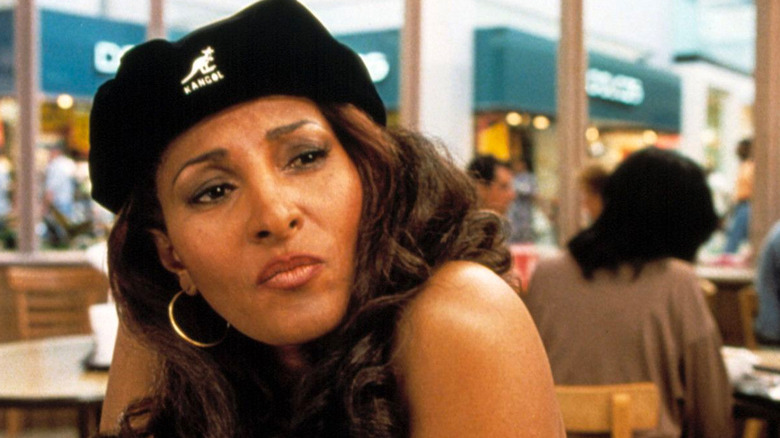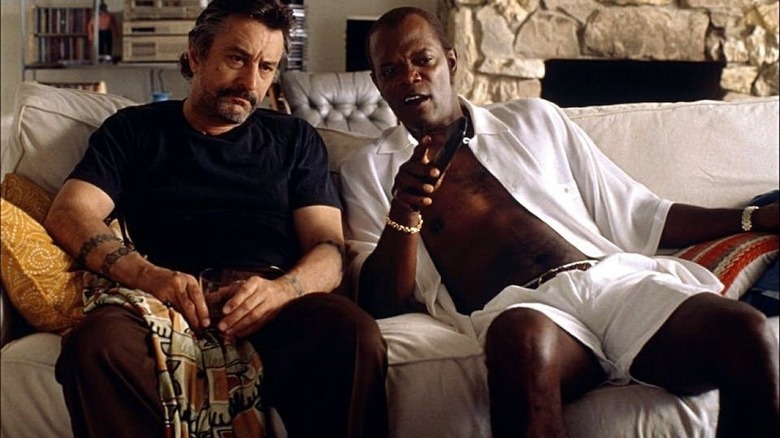Quentin Tarantino Doesn't Consider Jackie Brown Part Of His Cinematic Universe
"Jackie Brown" remains Quentin Tarantino's only departure from writing and directing his own films and, as such, it continues to stand just outside of the explosive, hyper-real universe he's created with all of his other features. Adapted from Elmore Leonard's 1992 novel "Rum Punch," Tarantino's follow-up after the unprecedented success of "Pulp Fiction" was intentionally crafted to fly right under the radar of the mainstream. The chances of duplicating the cultural phenomenon of "Pulp" just wasn't a possibility and whatever Tarantino was going to do next would be unfairly compared to what many still consider his masterpiece.
Until "Jackie Brown," Tarantino had essentially created his own cinematic universe (the QTCU?) populated by characters dreamt up by his own imagination. "Reservoir Dogs," "Pulp Fiction," "True Romance," and "Natural Born Killers" all have the same voice that remained intact even when other directors such as Tony Scott and Oliver Stone inserted their own established, stylized brand.
"Jackie Brown" is grounded in Elmore Leonard's literary universe featuring popular characters from his novels like Ordell, Louis, and Melanie, who were already featured in previous novels by Leonard, including 1978's "The Switch." Tarantino took those characters and added a few of his own flourishes, to the point where he even felt like he became the gangster Ordell Robbie (later played by Samuel L. Jackson). In an example of "method writing," the director tends to become the characters he's writing for, at times. "I spent a whole year basically being Ordell," Tarantino said in a 1998 issue of Creative Screenwriting magazine. "I couldn't shut him off and I didn't want to. And in a weird way Ordell is the rhythm of the movie."
The natural rhythm of Jackie Brown
For "Jackie Brown," Quentin Tarantino abandoned the excessive dialogue he had become famous for, preferring to use a much more naturalistic style that played to the strengths of the characters. Not everyone talks like Tarantino, they speak in their own voice. Samuel L. Jackson's vocal rhythm as L.A. Kingpin Ordell Robbie became the musical beat of the movie that Pam Grier locked onto during filming. "Quentin told me that Sam had a metronome-like quality that's really fast, but that I'd have to slow down for Robert [Forster]," she told The Hollywood Reporter. "He warned me that not all actors can do that, so I had to learn."
Using the natural cadence of actors like Jackson and Forster allowed Tarantino to organically bring out Leonard's voice from "Rum Punch" without adding too many recognizable touches of his own. "This is in Elmore Leonard's universe and it was interesting making a movie outside this little universe that I created," explained Tarantino.
Wanting to differentiate "Jackie Brown" even more from his style of filmmaking, Tarantino changed the look of the film to better compliment Leonard's established crime world:
"I wanted it to be ultra-realistic. I used a different cinematographer to kind of get a different look. It still looks great but just a little bit more down to earth, a little less like a movie movie, a little bit more like a '70s 'Straight Time.'"
Starring Dustin Hoffman as a career burglar out on parole, "Straight Time" really does look visually similar to "Jackie Brown" in spots, especially in a few office scenes that closely resemble Max Cherry's Bail Bonds business. Tarantino also filmed "Jackie Brown" entirely on location in L.A. and shot the film with a 1.85:1 ratio, the only time he's used the format for one of his features.

